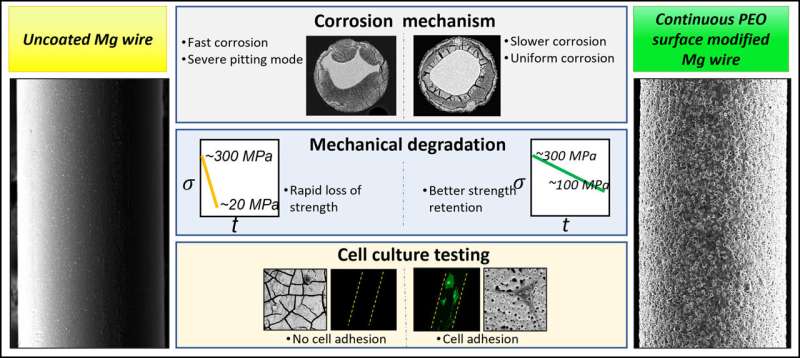This article has been reviewed according to Science X's editorial process and policies. Editors have highlighted the following attributes while ensuring the content's credibility:
fact-checked
proofread
Researchers develop scalable and continuous surface modification process for magnesium alloy wires

Researchers from IMDEA Materials Institute and German medical equipment manufacturer Meotec GmbH have developed the world's first industrially scalable surface modification process for bioabsorbable magnesium alloy wires.
The findings, as reported in two recently published scientific papers in the journal Biomaterials Advances, could have a significant impact in the future use of such wires for biomedical applications.
Surface-modified magnesium wires offer enormous potential in the biomedical field, from use in implants, wound closure, cardiovascular stents, nerve regeneration, and as polymer reinforcement in trauma fixation plates.
The two recently released publications outline how researchers created a novel technique for the fabrication and continuous surface modification of wires from WE43 magnesium alloy by means of Plasma Electrolytic Oxidation (PEO).
By improving the surface resistance to corrosion, the new process allows scientists to overcome two of the greatest hurdles to the use of magnesium wires in biomedical implants: their quick rate of degradation and their resulting early loss of mechanical performance.
"You won't find any commercially approved, magnesium wire-based medical devices currently on the market because the high surface-to-volume ratio of magnesium wire results in its rapid degradation rate," explained IMDEA Materials researcher and Marie Curie Fellow Syed Wahaaj Ali Rizvi.
"However, by applying these new developments in surface modification, we are able to not only reduce that degradation rate, we were also able to improve their mechanical and biological performance."
"For instance, in our recent study, we show that without surface modification, the wires dissolved in an accelerated test environment facilitating simulated bodily fluid at 37 degrees within 24 hours. With our modifications, they remained intact for seven days. And even after four days, they were still demonstrating more than 100 MPa of strength, which is suitable for a number of medical applications."
Rizvi was one of a number of researchers involved in the publications, alongside fellow IMDEA Materials scientists Prof. Javier Llorca, Prof. Carlos González, Dr. Mónica Echeverry Rendón, Dr. Muzi Li and Guillermo Dominguez. The work also relied on the contributions of Meotec's Dr. Alexander Kopp, Leon Tillman, Tim Mayer and Kerstin van Gaalen, who was another Marie Curie Fellow within the program.
Meotec's Dr. Kopp expressed confidence that the research would lead to a greater industrial interest in the further development and use of surface-modified magnesium wires.
"We are expecting that our new continuous PEO process ('C-PEO') will generate a considerable impact in industry," he said. "Since PEO is one of the most important surface treatments to improve surface resistance and corrosion."
"As magnesium is prone to corrosion, the high surface fraction and the aspect ratio of such wires means that a proper surface treatment is of utmost importance. Now, such PEO treatment can potentially be scaled up to high productivity lines by going from a batch to a coil-to-coil process."
The studies also show that the novel technique of surface modification resulted in a more uniform corrosion pattern of the wires as they dissolved. While altering the superficial structure to create a more porous structure also proved more conducive to the survivability of the cells required for regenerative tissue growth.
The next step in the development of a new line of magnesium wire-based medical devices could require completion of additional clinical trials.
More information: Wahaaj Ali et al, Bioabsorbable WE43 Mg alloy wires modified by continuous plasma-electrolytic oxidation for implant applications. Part I: Processing, microstructure and mechanical properties, Biomaterials Advances (2023). DOI: 10.1016/j.bioadv.2023.213314
Wahaaj Ali et al, Bioabsorbable WE43 Mg alloy wires modified by continuous plasma electrolytic oxidation for implant applications. Part II: Degradation and biological performance, Biomaterials Advances (2023). DOI: 10.1016/j.bioadv.2023.213325
Provided by IMDEA Materials





















